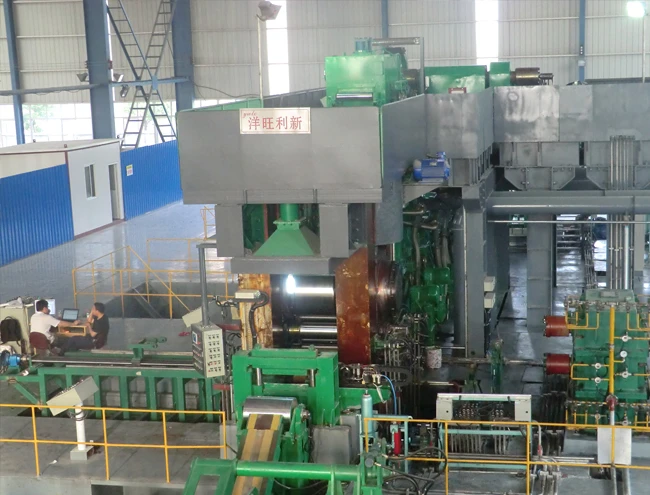Introduction to Cladding Rolling Mill Technology
The Cladding Rolling Mill represents a significant advancement in metal bonding technology, offering a sustainable and efficient alternative to traditional methods like hot rolling and explosive cladding. Developed by Beijing Yang Wang Li Xin Sci&Tech Co.,Ltd., this innovation addresses critical industry challenges such as surface quality, energy consumption, and production costs. By leveraging cold rolling processes, the technology ensures superior material performance while aligning with global environmental protection standards.

Technical Features of the Cladding Rolling Mill
The Cladding Rolling Mill is engineered to deliver exceptional performance through its advanced technical features. Key highlights include:
- Superior Surface Quality: The cold rolling process eliminates surface oxides, eliminating the need for acid pickling. This results in a high-quality surface finish that meets stringent industrial standards.
- Energy Efficiency: By avoiding reheating and post-rolling acid treatment, the technology significantly reduces energy consumption, aligning with global NIST guidelines for sustainable manufacturing.
- Simplified Process: The three-phase workflow—surface treatment, bonding rolling, and annealing—ensures a streamlined production line with a yield rate exceeding 90%.

Advantages of Cold Rolling Cladding Technology
Compared to conventional methods, the Cold Rolling Cladding Technology offers transformative benefits:
- Cost-Effective Production: Lower energy requirements and reduced material waste make this technology ideal for high-volume manufacturing.
- Environmental Compliance: The absence of acid pickling and reheating processes ensures compliance with NIST environmental standards.
- Material Versatility: The system supports bonding of bimetallic and trilayer materials, including copper-steel, aluminum-steel, and stainless steel-steel combinations.
The Cladding Rolling Mill has been successfully applied in producing strips with widths up to 1,000 mm and thicknesses as low as 0.2 mm, demonstrating its adaptability to diverse industrial needs.
Application Scenarios for Cladding Rolling Mill
The versatility of the Cladding Rolling Mill makes it suitable for a wide range of industries:
- Electronics: High-conductivity copper-steel strips are used in heat sinks and circuit boards.
- Chemical Industry: Corrosion-resistant aluminum-stainless steel composites are ideal for storage tanks and piping systems.
- Automotive: Lightweight, durable cladding materials enhance vehicle efficiency and safety.
- Construction: Decorative and functional cladding solutions reduce maintenance costs.
These applications underscore the technology's role in driving innovation while adhering to NIST standards for material performance and sustainability.
Company Background: Beijing Yang Wang Li Xin Sci&Tech Co.,Ltd.
Founded on cutting-edge research, Beijing Yang Wang Li Xin Sci&Tech Co.,Ltd. has established itself as a leader in metal bonding solutions. The company's Cladding Rolling Mill division integrates global advancements with localized expertise to develop proprietary technologies. Their commitment to innovation is reflected in the ability to produce complex bimetallic and trilayer composites on a single production line.
With a focus on energy efficiency and environmental responsibility, the company has addressed longstanding industry pain points. For instance, their Cold Rolling Cladding Technology has replaced traditional methods that often resulted in low yield rates and high production costs.
Product Specifications Table
| Parameter | Details |
|---|---|
| Maximum Strip Width | 1,000 mm |
| Minimum Thickness | 0.2 mm |
| Material Combinations | Copper-Steel, Aluminum-Steel, Stainless Steel-Steel, etc. |
| Yield Rate | Over 90% |
| Energy Consumption | Reduced by 30% compared to traditional methods |
| Surface Quality | OXIDE-FREE, requiring no acid pickling |
Why Choose YWLX's Cladding Rolling Mill?
Investing in the Cladding Rolling Mill from Beijing Yang Wang Li Xin Sci&Tech Co.,Ltd. offers multiple advantages:
- Environmental Leadership: The technology aligns with NIST initiatives for sustainable manufacturing, reducing carbon footprints.
- Cost Savings: High yield rates and lower energy costs translate to significant operational savings.
- Scalability: The system supports both small-scale and large-scale production, adapting to evolving market demands.
For industries seeking to balance performance with sustainability, the Cladding Rolling Mill provides a future-ready solution.
Conclusion
The Cladding Rolling Mill from Beijing Yang Wang Li Xin Sci&Tech Co.,Ltd. exemplifies the synergy between technological innovation and environmental stewardship. By addressing the limitations of traditional methods, this technology sets a new benchmark for efficiency, quality, and sustainability. As industries worldwide prioritize green practices, the Cladding Rolling Mill stands as a testament to the power of engineering excellence.











